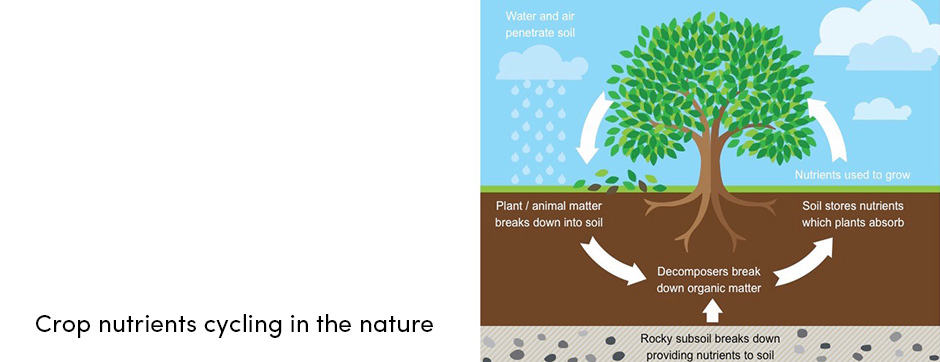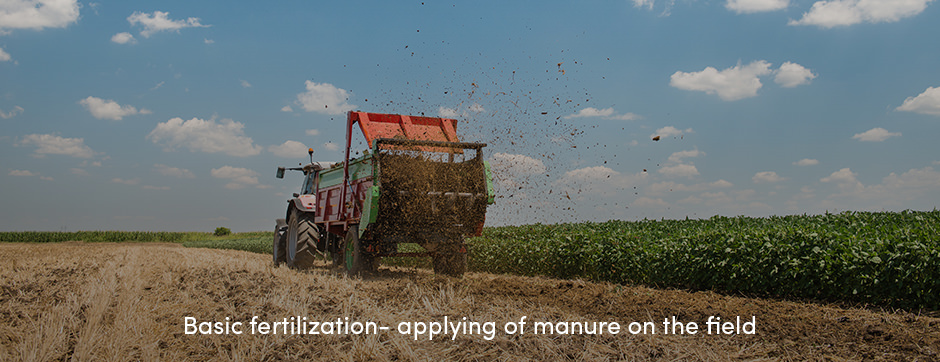Crop nutrients are elements that are essential in providing healthy and vigorous plants. They are the backbone of the entire crop production. Without crop nutrients, very little to not yield can be expected.
All plant nutrients can be categorized based on the quantity required by the plant for proper growth:
- macronutrients – N, K, P, S, Ca, Mg
- micronutrients – Fe, Mn, B, Cu, Zn, Cl, Mo, Ni
The three macronutrients are considered to be the main plant nutrients, those most responsible for plant growth. Those that have a major hand in creating plant parts include:
- nitrogen (N) – encourages germination and vegetative plant growth
- phosphorus (P) – necessary for energy storage and transport, root development, seed production, and enhancing crop maturity and quality
- potassium (K) – enhances plant strength to combat stress, increases efficiency of water use
Although plants need micronutrients in small quantities, it doesn’t mean that they are less important to plant growth. They are just vital and efficient as those required in greater quantity. However, the quantities of nutrients depend on many additional factors including;
- Crop
- Variety
- Climate
- Soil properties
- Fertilization management.
Combined together, the aforementioned factors will influence the nutrient need and overall crop yield.
The Source of Plant Nutrients
Plant nutrients are all around us; in the air (N), water, and in the soil, as well as in many other natural materials. Due to specific soil properties and often its poor condition, the soil can’t always provide enough nutrients for plant growth. Because of this, farmers need to add additionally crop nutrients to the soil.
There are various sources of plant nutrients. They can be in the form of an organic source, such as plant debris, green manure, compost, waste, or manure or an artificial source, such as chemical fertilizers. Although each type of fertilizer has their benefits they also have drawbacks as well. However, they play a key role in crop production and the increasing of productivity. For this reason, the correct balance of nutrients is crucial.
Although organic and chemical fertilizers add the same types of nutrients to the soil, organic fertilizers work in a different way. Organic fertilizers provide nutrients to plants while feeding the soil, creating an organic soil matter. Organic fertilizers provide nutrients for all microorganisms living in the soil and work to produce a healthy soil.
When to Apply Fertilizers?
Fertilizers boost the soil’s reserve of nutrients essential to the healthy growth and development of plants.
Plant nutrients are applied throughout the entire crop production cycle; from the time of soil maintenance for growing crops to the entire crop vegetation and end of the growing season. The time of fertilizer application will determine the type and amount of crop nutrients needed. According to the application time, there are three known main fertilization types:
- Basic fertilization
- Pre-sowing fertilization
- Supplementary fertilization.
Understanding of crop needs can significantly help farmers determine the optimal timing for fertilizer applications. Knowing when to apply crop nutrients is only one aspect of successful crop production. To achieve the optimum yield, a farmer needs to consider other aspects as well, such as:
- The rate to apply
- The method
- The source of plant nutrients
- The influence of soil and climatic conditions on nutrients.
The recommended farm practice is to apply fertilizers at specific plant growth stages so that nutrients are available when plants need them most. In doing so, a farmer can increase the efficiency of nutrient use and significantly reduce potential adverse effects of fertilizers on the environment.
Prior to crop fertilization, a farmer has one important task to perform – analyze his soil. Used to determine the exact nutrient level in the soil, chemical soil analysis is an important step in a good farm management. In reviewing the soil analysis, the farmer has a clear picture of how to treat the soil to ensure plants an ideal growth media.
In farming, there is no place for strong heads and those who practice various farm practices by heart, especially crop fertilization. Crops have strictly determined growth conditions and we need to consider them.
Text sources: Carteret County Center
Image sources: Bio Ninja







